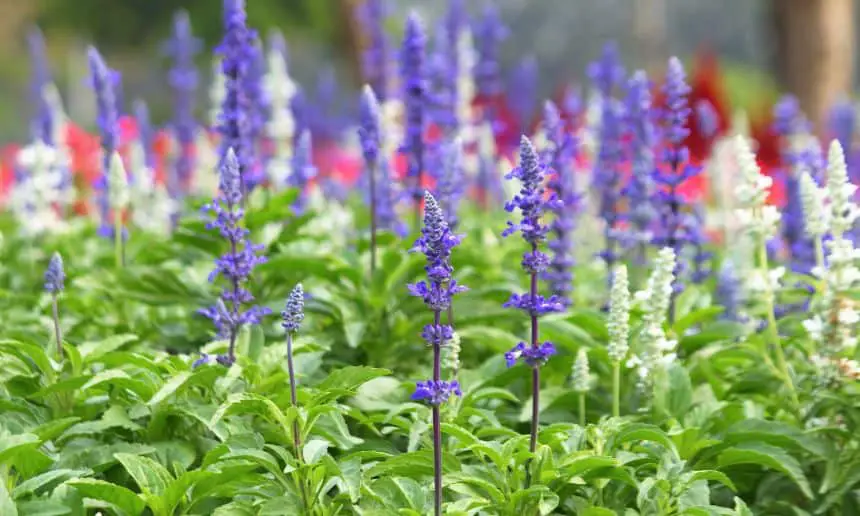Salvias are popular perennial flowers known for their spiky blooms that attract hummingbirds and butterflies. However, these plants can fall victim to various chewing pests that damage their foliage. If you’ve noticed ragged holes or skeletonized leaves on your salvias, here are some likely culprits and how to stop them from eating your plants
Common Salvias Pests
Several insects and gastropods are attracted to the tasty foliage of salvias. Watch for these common salvia pests:
-
Caterpillars – Many moth and butterfly larvae love munching on salvia leaves. Check undersides of leaves for green, brown or black caterpillars.
-
Beetles – Leaf beetles, flea beetles, and Japanese beetles eat small holes in leaves. Japanese beetles skewer leaves between their spiky legs as they feed.
-
Slugs and snails – Nocturnal slugs and snails make large, irregular holes with smooth edges Look for their slimy trails.
-
Leafminers – These small flies lay eggs inside leaves. The larvae tunnel between the leaf surfaces, creating winding trails or blotches.
-
Aphids – Tiny pear-shaped aphids cluster on new growth and undersides of leaves, sucking out plant fluids.
-
Thrips – Minuscule thrips rasp and feed on leaves, causing silver streaks, dots, or distorted growth.
-
Earwigs – Crescent-shaped notches on leaf edges may signal night-feeding earwigs.
Stop Salvias Pests with these Solutions
If pests are eating holes in your salvias, take action to protect your plants. Here are some effective, eco-friendly solutions:
-
Handpick pests – Check plants daily and crush larger pests like caterpillars, slugs, and beetles. Drop in soapy water.
-
Use row covers – Cover plants with fabric row covers to create a physical barrier against pests.
-
Apply organic insecticides – Spray plants with OMRI-listed insecticidal soaps, neem oil, or spinosad to kill larvae and soft-bodied insects.
-
Use beneficial nematodes – Water in nematodes to naturally kill soil-dwelling pests like earwigs.
-
Set beer traps – Sink cups of beer in soil to attract and drown slugs and snails.
-
Spread diatomaceous earth – Sprinkle this abrasive powder on soil to shred soft slug and snail bodies.
-
Clean up debris – Remove plant litter and weeds where pests hide.
-
Attract natural predators – Plant flowers that support beneficial wasps, ladybugs, lacewings, and birds that prey on pests.
-
Rotate salvias – Move plants to a new spot in your garden each season to disrupt pest cycles.
-
Improve soil – Enrich soil with compost to strengthen plants and help them recover from pest damage.
Identify the Culprit
To determine exactly what is munching on your salvias, inspect plants closely first thing in the morning or at night with a flashlight. Look for evidence like:
-
Green caterpillars on leaves or under debris at plant base
-
Slug or snail trails across soil and chewed leaves
-
White butterflies hovering around plants, signaling caterpillar larvae
-
Clusters of small insects on undersides of leaves
-
Skeletonized leaves, only veins remaining
-
Jagged notches along leaf edges
-
Tiny specks moving on leaves
-
Crescent-shaped bite marks on leaf margins
How to prevent pests from eating salvias, perennials and ornamentals?
- Subscribe to RSS Feed
- Mark Topic as New
- Mark Topic as Read
- Float this Topic for Current User
- Bookmark
- Subscribe
- Mute
- Printer Friendly Page
Re: how to get rid of pests eating my salvias, perennials and oranamentals
That damage would be consistent with caterpillars or slugs. The Baythroid would be suitable for caterpillars, or you could use Dipel. The chew marks are not quite as semi-circular as what I would normally expect to see from a caterpillar, so I suggest you treat from slugs, too. I recommend using Eco-Organic Garden 600g Eco-Shield Organic Snail & Slug Killer.
Heres a helpful guide: Protect your garden from snails, slugs and leaf eaters.
Please let me know if you have any questions.
How to Prune Salvia to Get Continuous Blooms!! Learned this by Accident! My Selective Pruning Method
What eats salvia plants?
Slugs and Snails are the most common pests of Salvias. Gophers and Chickens also cause great damage to your Salvia plants. Birds like Finches love to munch on Salvia seeds. Squirrels damage your Salvia plants by digging ’em up. Salvias are grown for their colorful blossoms. The genus Salvia contains a number of species.
How do you protect salvias from pests and diseases?
To protect Salvias from pests and diseases, it’s crucial to identify culprits, employ natural remedies, and set up physical defenses. I’ve noticed that the most prevalent pests on Salvias include slugs, snails, aphids, spider mites, and caterpillars. Deer and rabbits can also nibble on these plants.
Are salvias poisonous?
Salvias, commonly known as sage plants, are a popular choice among gardeners for their beautiful flowers, aromatic foliage, and ability to attract pollinators. However, like any other plant, salvias are susceptible to various pests that can cause damage and hinder their growth.
What if my Salvia plant is leggy?
Solution: If your Salvia plant is leggy, consider transplanting it to a sunnier location. Keep in mind that it may take some time for the plant to adjust to the new location, but with proper care, new growth should appear less leggy and more compact. 6. Yellowing of Leaves
- The Ultimate Guide to Growing Strawberries in Raised Beds - August 8, 2025
- No-Dig Garden Beds: The Easiest Way to Grow a Beautiful Garden - August 6, 2025
- How to Protect and Preserve Wood for Raised Garden Beds - August 6, 2025

